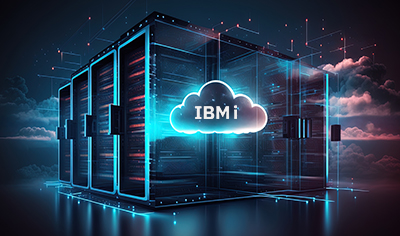Historically and even today, a majority of IBM i users prefer to run their mission-critical workloads or applications on-premises. According to the 2023 IBM i Marketplace Survey Results, enterprises are planning to run nearly 80% of their IBM i workloads on-premises. However, the important thing to note is that there is also a gradual shift in using IBM i in the Cloud.
When asked customers about what IBM i workloads they are running in the Cloud, a sharp increase in critical segments has been observed. For instance, test and development surged from 53% to 65%, a staggering rise of 12%. Similarly, core business applications jumped from 58% to 65%, an uptick of 7% compared to the previous year. This clearly indicates a strong customer interest in migrating mission-critical applications like ERP from AS400 Systems to the Cloud to harness a multitude of business benefits including reduced complexity, improved scalability, increased flexibility, reduced costs, and competitive advantage.
When asked customers about what IBM i workloads they are running in the Cloud, a sharp increase in critical segments has been observed. For instance, test and development surged from 53% to 65%, a staggering rise of 12%. Similarly, core business applications jumped from 58% to 65%, an uptick of 7% compared to the previous year. This clearly indicates a strong customer interest in migrating mission-critical applications like ERP from AS400 Systems to the Cloud to harness a multitude of business benefits including reduced complexity, improved scalability, increased flexibility, reduced costs, and competitive advantage.

Why Migrating Workloads From AS400 to the Cloud Makes Sense
Running mission-critical workloads or applications on legacy AS400 Systems may pose a slew of challenges to businesses such as high server upgrade costs, poor usability and manageability, data security nightmares, lack of readiness for modern business solutions and emerging technologies, incompatibility with the Cloud, and more. The good news is that enterprise-level organizations can overcome these challenges with AS400 Cloud migration. Furthermore, migrating legacy IT assets from on-premise to the Cloud enables enterprises to become more agile and efficient by quickly pivoting with ever-changing business requirements, leveraging the potential of modern technologies, and keeping pace with the current IT landscape. Now, let’s dig deeper into the key benefits of AS400 migration to the Cloud.

1. Reduced Operational Costs
Enterprise-level organizations prefer to run mission-critical ERPs on AS400 Systems. However, with continuous business expansion over the years, many of them are grappling with challenges such as scalability and high maintenance costs. With AS400 Cloud migration, enterprises can cut down on high operational costs whilst improving the scalability of their IT assets. The best thing about migrating workloads from AS400 to the Cloud is the “pay-as-you-go” model offered by many leading Cloud service providers, wherein, enterprises need to pay only for computing resources they use on the Cloud environment per month. In other words, running mission-critical workloads on the Cloud is way cheaper than on physical servers. This significant cost benefit enables organizations to save a fortune in the long run.
Legacy to the Cloud: A Winning Guide to App Modernization
2. Architecture Flexibility
Another key advantage of migrating workloads and applications from AS400 to the Cloud is unmatched flexibility. When workloads are migrated to the Cloud environment from on-premise, they become independent and no longer rely on hardware resources, which in turn, makes the system future-ready. In other words, AS400 migration to the Cloud makes IBM i applications more adaptive to changing business requirements and meet unanticipated demand levels.
3. Low Maintenance Overheads
Hosting workloads on-premise demands regular maintenance including hardware upgrades, software updates, and more, which adds substantially to the overhead costs. Migrating workloads to the Cloud helps businesses in reducing the cost of daily system maintenance. With Cloud as the hosting environment, enterprises don’t need to designate a team of experts for regular maintenance as the Cloud vendor takes care of almost all the aspects. It is believed that Cloud hosting can lower the cost of system maintenance by nearly 30%-70% as compared to on-premises.
The Ins and Outs of AS400 Application Modernization
4. Quick Disaster Recovery
IT disaster threats always loom over organizations using legacy assets such as AS400 Systems. Whether caused by hardware failure, software error, or malicious ransomware, an IT disaster may lead to a loss of access to critical data and systems, a complete shutdown, and a substantial delay in response to vendors and customers – all these can negatively impact the reputation of an organization and its bottom-line. Fortunately, businesses can overcome the threats of an IT disaster by migrating workloads from on-premise to the Cloud. With AS400 Cloud migration, organizations can quickly recover the data and make their operations immune to IT disasters by minimizing downtime. Unlike traditional disaster recovery that relies on secondary servers or data centers for the backup and is also highly time-intensive, Cloud-based migration ensures rapid recovery of the systems during a disaster at reduced costs.
The Key to a Flourishing Future is iSeries App Modernization
Summing Up
Migrating workloads from on-premise to the Cloud can be tedious, time-intensive, and nerve-wracking. This may be the reason why enterprise-level organizations using AS400 systems try to avoid migrating workloads to the Cloud. However, running mission-critical applications on legacy IT assets may prevent enterprises from missing out on a host of opportunities offered by the Cloud such as reduced costs, increased data security, better flexibility, improved scalability and agility, and more. Therefore, it makes sense to make IBM i applications future-ready by embracing the Cloud solution. Partnering with an AS400 migration expert can help businesses sail through a long and complicated process of moving workloads from on-premise to the Cloud.
Case in Focus
A leading US-based Auto & Home Insurance company was looking for an expert who could help the insurer with database migration and maintenance support for their AS400 legacy applications. Damco partnered with the client and scaled up their legacy applications to make the migration successful. Read the detailed case study to find out how Damco successfully migrated the database with zero downtime.





